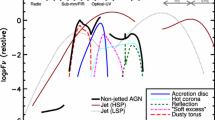Abstract
We calculate the parameters of the two-point correlation function of quasars w(r) = (r c /r)γ on the basis of the SDSS DR3 data. The correlation functions are first determined from projected distances with the use of a special technique for compiling randomized catalogs. Next the parameters of the spatial correlation function are obtained with the assumption of local isotropy. For the quasars with redshifts z = 0.8–2.1, we obtained the estimates γ = 1.76 ± 0.14, r c = 6.60 ± 0.85 h −1 Mpc in the comoving distance range 2–30 Mpc and γ = 1.90 ± 0.11, r c = 6.95±0.57 h −1 Mpc in the range 2–50 Mpc. These estimates agree, within the limits of errors, with the estimates obtained for the redshifts 0.4 < z < 2.1. The original catalog shows some deficit of pairs with separations less than 1 Mpc.
Similar content being viewed by others
References
Weinberg, S., Gravitation and Cosmology: Principles and Applications of the General Theory of Relativity, Wiley, 1972.
Peebles, P.J.E., The Large-Scale Structure of the Universe, Cambridge: Cambridge Univ., 1980.
Alcock, C. and Paczynski, B., An Evolution Free Test for Non-Zero Cosmological Constant, Nature, 1979, vol. 281, pp. 358–359.
Budavary, T., Connoly, A.J., Szalay, A.S., et al., Angular Clustering with Photometric Redshifts in the Sloan Digital Sky Survey: Bimodality in the Clustering Properties of Galaxies, Astrophys. J., 2003, vol. 595, no. 1, pp. 59–70.
Connoly, A.J., Scranton, R., Johnston, D., et al., The Angular Correlation Function of Galaxies from Early Sloan Digital Sky Survey Data, Astrophys. J., 2002, vol. 579, no. 1, pp. 42–47.
Croom, S.M., Boyle, B.J., Shanks, T., et al., The 2dF QSO Redshift Survey. XIV. Structure and Evolution from the Two-Point Correlation Function, Mon. Notic. Roy. Astron. Soc., 2005, vol. 356, no. 2, pp. 415–438.
Croom, S.M., Shanks, T., Boyle, B.J., et al., The 2dF QSO Redshift Survey. II. Structure and Evolution at High Redshift, Mon. Notic. Roy. Astron. Soc., 2001, vol. 325, no. 2, pp. 483–496.
Croom, S.M., Smith, R.J., Boyle, B.J., et al., The 2dF QSO Redshift Survey. XII. The Spectroscopic Catalogue and Luminosity Function, Mon. Notic. Roy. Astron. Soc., 2004, vol. 349, no. 4, pp. 1397–1418.
Hamilton, A.J.S., Toward Better Ways To Measure the Galaxy Correlation Function, Astrophys. J., 1993, vol. 417, p. 19.
Hawkins, E., Maddox, S., Cole, S., et al., The 2dF Galaxy Redshift Survey: Correlation Functions, Peculiar Velocities and the Matter Density of the Universe, Mon. Notic. Roy. Astron. Soc., 2003, vol. 346, no. 1, pp. 78–96.
Hennawi, J.F., Sreauss, M.A., Ogury, M., et al., Binary Quasars in the Sloan Digital Sky Survey: Evidence for Excess Clustering at Small Angles, Astron. J., 2006, vol. 131(1), pp. 1–23.
Ivashchenko, A.Yu. and Zhdanov, V.I., The Angular Correlation Function of Quasars from SDSS DR3, WDS’06 Proc. of Contributed Papers: Part III—Physics, Safrankova, J. and Pavlu, J., Eds., Prague: Matfyzpress, 2006, pp. 24–26.
Landy, S.D. and Szalay, A.S., Bias and Variance of Angular Correlation Functions, Astrophys. J., 1993, vol. 412, no. 1, pp. 64–71.
Martinez, V.J. and Saar, E., Clustering Statistics in Cosmology, SPIE Proc.: Astron. Data Analysis II, Starck, J.-L. and Murtagh, F.D., Eds., 2002, vol. 4847, pp. 86–100.
Myers, A.D., Brunner, R.J., Richards, G.T., et al., First Measurement of the Clustering Evolution of Photometrically Classified Quasars, Astrophys. J., 2006, vol. 638, no. 2, pp. 622–634.
Porciani, C., Magliocchetti, M., and Norberg, P., Cosmic Evolution of Quasar Clustering: Implications for the Host Haloes, Mon. Notic. Roy. Astron. Soc., 2004, vol. 355, no. 3, pp. 1010–1030.
Schneider, D.P., Hall, P.B., Richards, G.T., et al., The Sloan Digital Sky Survey Quasar Catalog. III. Third Data Release, Astron. J., 2005, vol. 130, no. 2, pp. 367–380.
Spergel, D.N., Bean, R., Dore, O., et al., Wilkinson Microwave Anisotropy Probe (WMAP) Three Year Results: Implications for Cosmology, arXiv:astro-ph/0603449.
Zhdanov, V.I. and Surdej, J., Quasar Pairs with Arcminute Angular Separations, Astron. and Astrophys., 2001, vol. 372, no. 1–7.
Zhdanov, V.I. and Surdej, J., Physical Grouping of Quasars from Veron-Cetty & Veron and 2dF Catalogs, Visnyk Kyiv. Un-tu. Ser. Astronomiia, 2003, vol. 39–40, pp. 78–80.
Author information
Authors and Affiliations
Additional information
Original Russian Text © V.I. Zhdanov, A.Yu. Ivashchenko, 2008, published in Kinematika i Fizika Nebesnykh Tel, 2008, Vol. 24, No. 1, pp. 3–14.
About this article
Cite this article
Zhdanov, V.I., Ivashchenko, A.Y. Correlation function of quasars from SDSS DR3. Kinemat. Phys. Celest. Bodies 24, 1–9 (2008). https://doi.org/10.1007/s11963-008-1001-y
Received:
Published:
Issue Date:
DOI: https://doi.org/10.1007/s11963-008-1001-y




